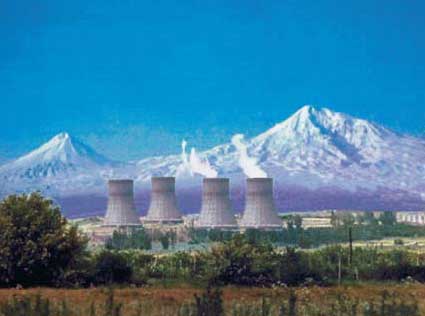


ArmInfo.The Armenian NPP will operate until 2027. Prime Minister of Armenia Karen Karapetyan stated this at a press conference.
He assured that the operation of the Armenian NPP meets safety standards, and there are ongoing works on its modernization. "Armenia was and will remain a country with nuclear power," Karapetyan said.
The Armenia-EU framework agreement, in particular, refers to the importance of compliance with the IAEA standards at a high level. It is also said about the closure and safe decommissioning of the nuclear power plant in Metsamor and cooperation on the previously adopted road map or action plan, taking into account the need to replace nuclear power plants with new opportunities to ensure Armenia's energy security.
The demand to close the ANPP is not new for the Armenian side. Back in 1999, the EU insisted on the closure of the second power unit of the ANPP by 2003. However, after the relevant negotiations, an amendment was introduced to this requirement, which read "until the creation of the appropriate capacity." In 2013, head of the EU delegation to Armenia Traian Christie stressed that the issue of exploitation of the Armenian nuclear power plant is one of the main issues on the agenda of Armenia-EU relations. In 2014, the European Commission again urged Armenia to close the nuclear power plant as soon as possible, as reflected in the European Commission's report on Armenia in the program of the European Neighborhood Policy. In 2015, the same Traian Christie reiterated that the early closure of the Armenian nuclear power plant and its decommissioning remained the main goal of the European Union. Despite its demands, the EU continued and continues to provide technical and financial assistance to the Armenian Nuclear Power Plant, aimed at improving the safety of the second power unit. According to various estimates, this assistance varies from 70 to 90 million EUR. In addition, the EU offered 200 million EUR for the closure of the ANPP, but the Armenian side rejected this proposal, considering these volumes insufficient to ensure the country's energy security.
Touching upon this, in an interview with RIA Novosti Armenian President Serzh Sargsyan stated that the discussions on the closure of the Metsamor nuclear power plant are artificially initiated and have nothing to do with reality. "In the draft agreement with the EU, this item was formulated by default (meaning the objective lifetime of the Metsamor nuclear power plant.) The Armenian government decided to extend the life of the Armenian nuclear power plant in March 2014. The NPP will be extended through the Russian state export credit in the amount of $ 270 million and a grant of $ 30 million.Today, together with the state corporation Rosatom, the work on the implementation of the extension program operation of the second power unit of nuclear power plants It is important to note that the NPP operates in full compliance with the IAEA criteria, and this is the conclusion of international specialized agencies. Measures to enhance project and operational safety and modernization are being implemented, so that Metsamor NPP will last until 2027. We believe that nuclear power will always be present in Armenia for its security, primarily energy," he said.
The Armenian nuclear power plant consists of two units with Soviet (Russian) WWER reactors. The first unit was commissioned in 1976, the second - in 1980. In March 1989, after the Spitak earthquake, which killed 25 thousand people, the station's work was stopped. In November 1995, in connection with the most acute energy crisis, the second power unit of the station with a capacity of 407.5 MW was involved. In March 2014, the Armenian government decided to extend the life of the second power unit by 10 years - until 2026. The project is coordinated by the subsidiary structure of the State Corporation Rosatom - JSC Rusatom Service. Completion of work is planned for 2019. The Government of the Russian Federation allocated a $ 270 million state export loan to Armenia and a $ 30 million grant for these purposes. In March 2015, the Joint Coordination Committee (JCC) was established to implement the program. So far, there have been five meetings of the JCC.